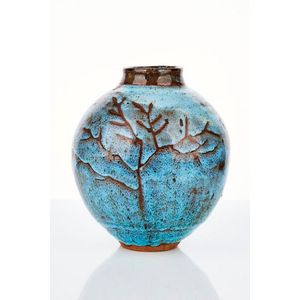Opalescent Lalique Perruches Vase on Bronze Base
You must be a subscriber, and be logged in to view price and dealer details.
Subscribe Now to view actual auction price for this item
When you subscribe, you have the option of setting the currency in which to display prices to $Au, $US, $NZ or Stg.
- Bronze - An alloy of copper and tin, traditionally in the proportions of about 9 parts of copper to 1 part of tin.
The discovery of bronze in Western Asia in the 4th century enabled people to create metal objects which were superior to those previoulsy possible because of its strength and hardness, and it has been used throughout the world for weapons, coins, tools, statuary and other decorative items.
It is very fluid in a molten state, and its hardness, strength when set, and non-corrosive properties makes it most suitable for casting sculpture. - Opalescent / Opaline - The descriptions of glass as "opalescent" or "opaline" are often used interchangeably by dealers and auction houses. At the upper end of the scale, opalescent / opaline glass can refer to the opal-like milky blue glass produced by Lalique and Etling. It also refers to the pressed glass mass produced in Britain from the 1840s with a milky white edge as sugar-basins, milk jugs and vases were made in great quantities for the mass market, and were sold at fairs along with Staffordshire figures and wooden dolls. A less common type of opalescent glass was made from two layers of glass blown into a mould.
- Engraved Glass - The method of decorating glass by marking the surface with a sharp intrument such as a diamond, metal needle or rotating cutting wheel. As pressure is applied to the surface, best results for engraving are achieved if the glass is of sufficient thickness. In the 19th century etching was used to decorate some table glassware that was too fine to take an engraving tool.
This item has been included into following indexes:
-
Lalique (France), item types
- other items 1,054
- vases 536
- Lalique (France), patterns, plates and bowls - Perruches 14
- Lalique (France), patterns, vases - Perruches 13
Visually similar items

Chinese blue and white porcelain jar of melon shape, decorated with fruits and squirrels. Height 17 cm

Emile Galle small cameo glass vase decorated with flowers, signed Galle. Height 7 cm

A superbly decorated Chinese lidded jar, with green enamel Imperial five clawed dragons within a border of Buddhist emblems. Six character underglaze blue Qianlong (1736-1795) mark underneath. No damage. Height 21 cm

Peter Rushforth (Australian, 1920-2015), Large Globular Pot, wheel thrown stoneware with open neck, flowing blue and brown glaze with crawling iron oxide in the design of a tree, artist's seal impressed near base, height 34 cm
